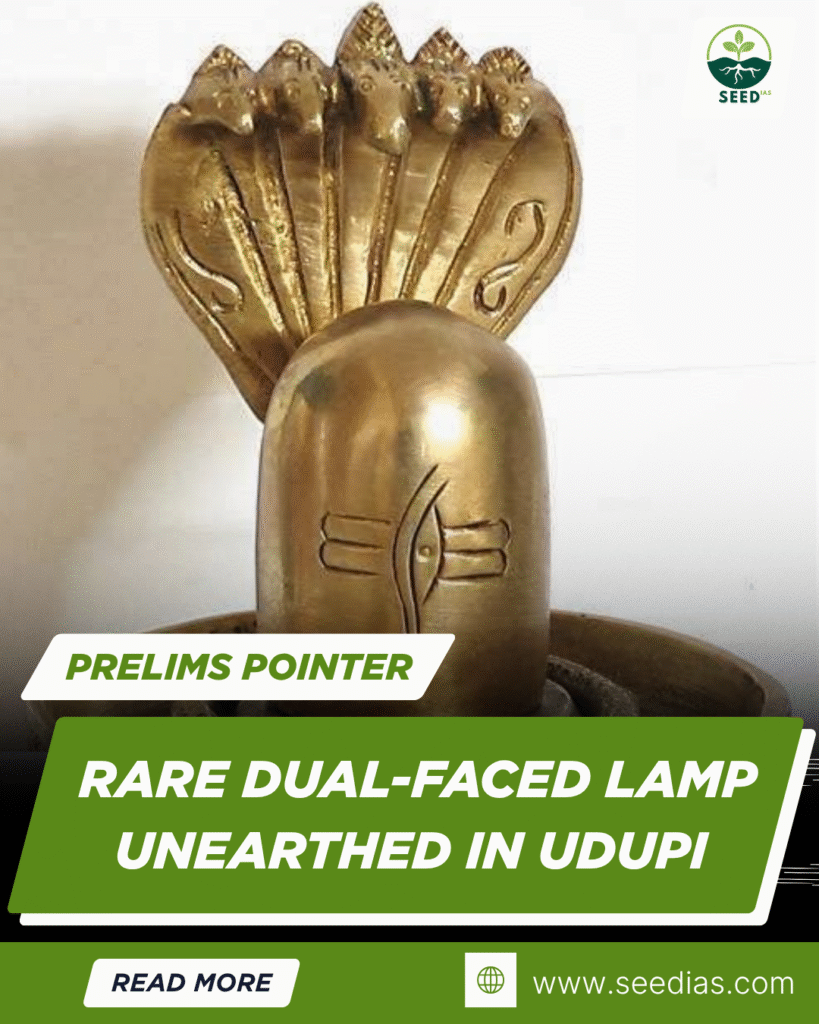Why in NEWS
A rare 15th-century dual-faced bronze lamp, symbolizing Shaiva-Vaishnava syncretism, has been discovered at the Perdoor Anantapadmanabha Temple in Udupi, Karnataka. It features intricate iconography from both traditions and offers insight into ritual and artistic integration in medieval South India.
Key Concepts & Terms
| Term | Explanation |
|---|---|
| Pralaya Tandava | Shiva’s cosmic dance of destruction during the end of creation |
| Anantapadmanabha | A reclining form of Vishnu resting on the serpent Ananta |
| Vismaya Mudra | Hand gesture expressing wonder or amazement |
| Samabhanga Pose | Balanced body posture with equal weight on both legs or limbs |
| Khadga Ravana | A folk form associated with Ravana, often linked to ancient deity worship |
News Details
The bronze lamp, dated to 1456 CE, was found in the outer prakara of the Perdoor temple. The lamp integrates Shaiva imagery on one side and Vaishnava imagery on the other, indicating ritual harmony and mutual reverence in temple worship practices of the era.
Faces of the Lamp: Symbolism & Deities
| Face | Description |
|---|---|
| First Face (Shaiva) | Shiva as Nataraja performing Pralaya Tandava, with Parvati, Ganapati, Bringi, and Khadga Ravana seated on Goddess Mari (in Vismaya Mudra) |
| Second Face (Vaishnava) | Vishnu as Anantapadmanabha surrounded by Brahma, Indra, Agni, and Varuna, requesting him to calm Shiva’s rage – symbol of cosmic balance |
Artistic Features
| Element | Description |
|---|---|
| Narrative Sculpture | High-relief storytelling with deities in dynamic yet composed forms |
| Samabhanga Posture | Reflects ideal aesthetics and balance in medieval temple sculpture |
| Headgear & Detailing | Differentiates divine roles and identities in the sculptural iconography |
Cultural and Religious Significance
| Aspect | Importance |
|---|---|
| Shaiva-Vaishnava Unity | Reflects historical efforts to integrate both sects under shared sacred space |
| Folk-Hindu Fusion | Worship of Khadga Ravana and Goddess Mari shows continuity of tribal traditions |
| Inscriptions | Confirm 15th-century origins and donor-backed religious patronage |
In a Nutshell
Memory Code: “LAMPAR”
Legacy of divine harmony
Artistic brilliance in Samabhanga
Mari and Khadga Ravana reflect folk links
Prayala Tandava meets Anantapadmanabha
Ancient inscription dated to 1456 CE
Ritual unity of Shaiva and Vaishnava devotion
Prelims Practice Questions
- The 15th-century dual-faced lamp discovered in Karnataka represents the integration of which two Hindu traditions?
A) Shaiva and Shakta
B) Shaiva and Vaishnava
C) Vaishnava and Ganapatya
D) Shaiva and Smarta - What does the “Vismaya Mudra” signify in Indian classical art?
A) Valor
B) Meditation
C) Wonder
D) Anger - In which of the following postures are the figures on the lamp primarily depicted?
A) Tribhanga
B) Lalitasana
C) Samabhanga
D) Abhanga
Mains Practice Questions
- (GS-1 – Art & Culture)
How do discoveries like the dual-faced lamp from Udupi reflect the socio-religious fabric of medieval South India? - (GS-1 – Art & Architecture)
Discuss the role of narrative sculptures in conveying religious philosophy and sectarian harmony in temple art.
Prelims Answer Key
| Qn | Answer | Explanation |
|---|---|---|
| 1 | B | The lamp depicts Shiva and Vishnu, indicating Shaiva-Vaishnava syncretism |
| 2 | C | Vismaya Mudra is a gesture denoting amazement or wonder |
| 3 | C | Samabhanga is a balanced pose used in classical sculpture |
















